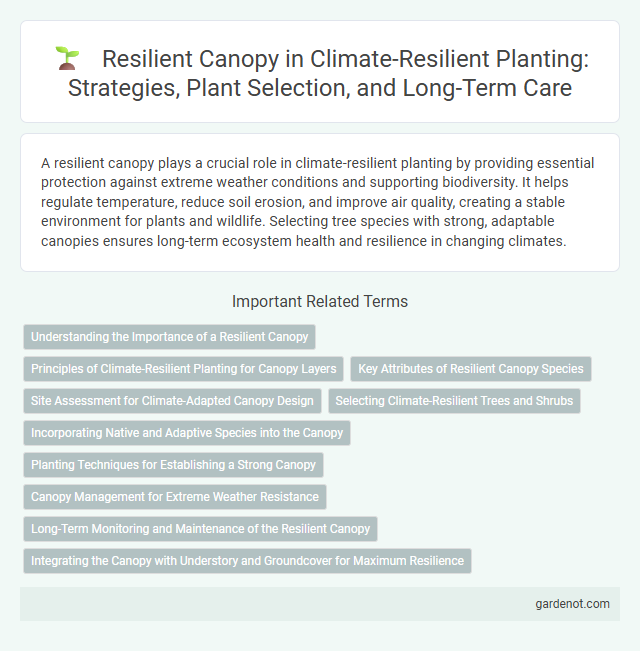A resilient canopy plays a crucial role in climate-resilient planting by providing essential protection against extreme weather conditions and supporting biodiversity. It helps regulate temperature, reduce soil erosion, and improve air quality, creating a stable environment for plants and wildlife. Selecting tree species with strong, adaptable canopies ensures long-term ecosystem health and resilience in changing climates.
Understanding the Importance of a Resilient Canopy
A resilient canopy enhances microclimate regulation by providing effective shade and reducing soil temperature fluctuations, which strengthens plant survival under climate stress. It plays a crucial role in maintaining biodiversity, supporting various species that depend on stable canopy structures for habitat. Prioritizing a resilient canopy in climate-resilient planting strategies ensures ecosystem stability and helps mitigate the impacts of extreme weather events.
Principles of Climate-Resilient Planting for Canopy Layers
Climate-resilient planting for canopy layers emphasizes selecting native, drought-tolerant tree species with deep root systems to enhance water retention and soil stability. Diverse species composition reduces vulnerability to pests, diseases, and extreme weather events while promoting ecosystem resilience. Structured layering optimizes light penetration and microclimate regulation, supporting both biodiversity and carbon sequestration.
Key Attributes of Resilient Canopy Species
Resilient canopy species exhibit key attributes such as deep root systems, high drought tolerance, and rapid recovery after environmental stressors. These species maintain carbon sequestration capacity and support biodiversity under fluctuating climate conditions. Their structural flexibility and resistance to pests and diseases enhance ecosystem stability and longevity.
Site Assessment for Climate-Adapted Canopy Design
Site assessment involves analyzing soil type, moisture levels, and sun exposure to select tree species that endure local climate stresses. Understanding microclimates enables optimal canopy architecture that mitigates heat and conserves water. Integrating native and drought-tolerant species enhances long-term canopy resilience against extreme weather events.
Selecting Climate-Resilient Trees and Shrubs
Selecting climate-resilient trees and shrubs involves prioritizing species with proven adaptability to extreme weather conditions such as drought, heat, and flooding. Trees like the drought-tolerant Live Oak (Quercus virginiana) and the flood-resilient Bald Cypress (Taxodium distichum) demonstrate robust canopy growth while withstanding climatic stressors. Incorporating native and well-adapted species enhances canopy resilience, supports local biodiversity, and maintains ecosystem stability under shifting climate patterns.
Incorporating Native and Adaptive Species into the Canopy
Incorporating native and adaptive species into the resilient canopy enhances ecosystem stability by improving resistance to pests, diseases, and extreme weather events. Native trees such as oaks, maples, and pines contribute to biodiversity while supporting local wildlife and soil health. Adaptive species optimize water use and carbon sequestration, making urban and rural landscapes more sustainable under changing climate conditions.
Planting Techniques for Establishing a Strong Canopy
Implementing planting techniques such as proper spacing, selecting native drought-tolerant species, and employing mulching improves soil moisture retention and promotes root development, fostering a resilient canopy. Strategic layering of understory and canopy trees enhances microclimate regulation, reduces wind stress, and supports biodiversity, crucial for climate adaptation. Root pruning and phased planting schedules contribute to robust canopy establishment, ensuring long-term ecosystem stability under variable climatic conditions.
Canopy Management for Extreme Weather Resistance
Resilient canopy management enhances plant survival and productivity under extreme weather by optimizing leaf structure, density, and orientation to reduce heat stress and water loss. Strategic pruning and selective thinning improve airflow and sunlight penetration, minimizing fungal diseases and increasing photosynthetic efficiency. Incorporating drought-tolerant species and adaptive rootstock further strengthens canopy resilience against fluctuating climate conditions.
Long-Term Monitoring and Maintenance of the Resilient Canopy
Long-term monitoring and maintenance of a resilient canopy are essential for sustaining its ability to withstand climate stressors such as drought, heat, and storms. Regular assessment of tree health, soil moisture levels, and pest infestations enables timely interventions to preserve canopy density and biodiversity. Implementing adaptive management practices based on monitoring data enhances canopy resilience and supports ecological stability over time.
Integrating the Canopy with Understory and Groundcover for Maximum Resilience
Integrating the canopy with understory and groundcover layers enhances climate resilience by creating a multi-tiered vegetation structure that improves microclimate regulation and soil stability. Diverse plant species in these layers increase ecosystem resistance to extreme weather events by promoting water retention, reducing erosion, and providing habitat connectivity. This holistic planting approach maximizes carbon sequestration and supports biodiversity, which are critical for long-term climate adaptation and resilience.
Resilient canopy Infographic

 gardenot.com
gardenot.com